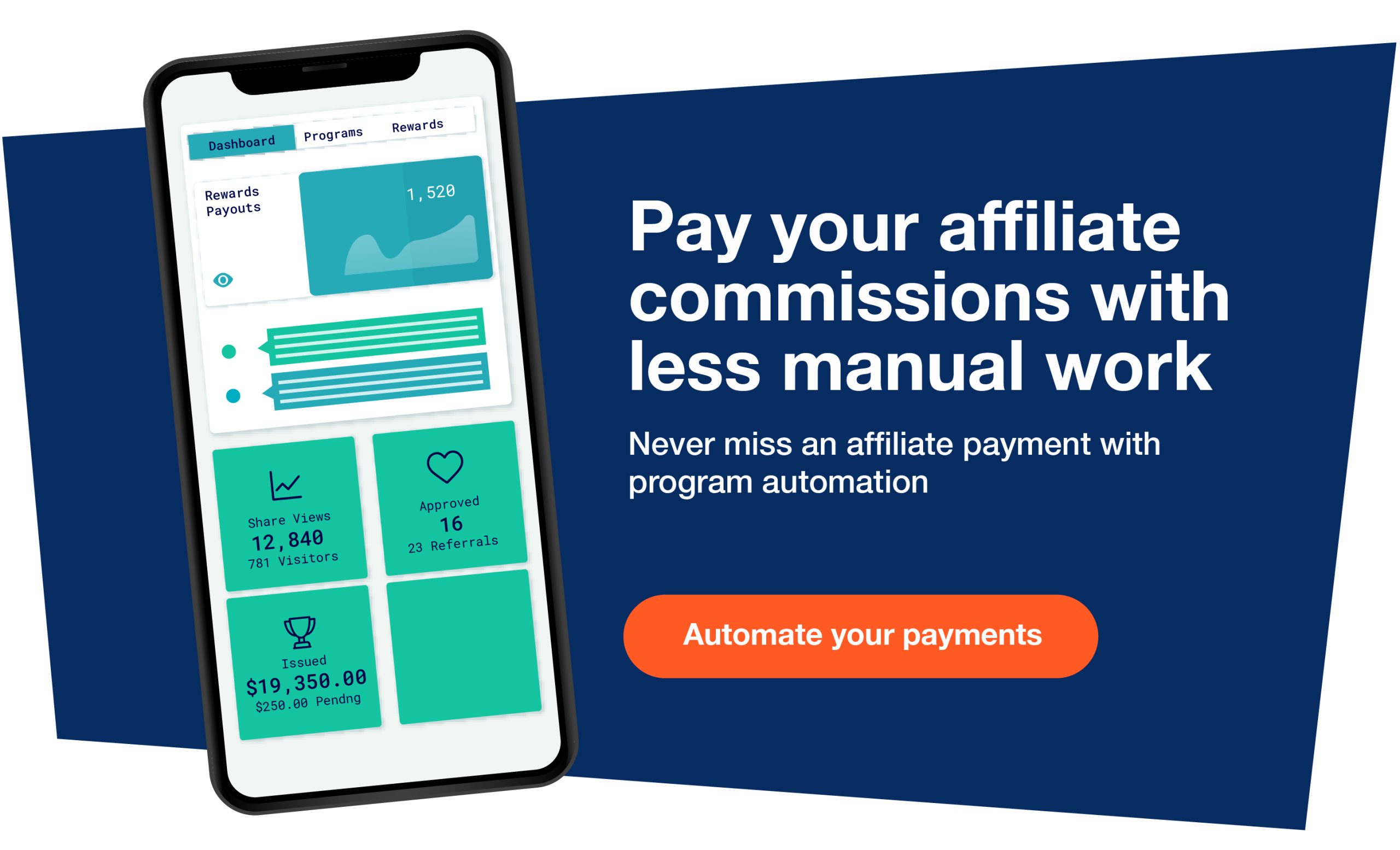Commissions are the backbone of affiliate marketing programs, and the incentive that keeps your affiliates motivated. When you run an affiliate program, you need to reward affiliates with a commission every time they help you make a sale via their affiliate link.
But how much should you pay your affiliates? Setting the right affiliate marketing commission rate is a balancing act. You need to choose a commission that attracts affiliate partners and encourages them to keep sending you customers. But also one you can afford to keep paying consistently.
If your affiliate commission is too low, it will be difficult to recruit affiliates, and they may simply go with your competitor’s offer. But if your commission is too high, it could eat into your profits.
Setting the right affiliate commission rate (and affiliate commission conditions) takes work. Fortunately, there’s a formula.
Follow these steps, and you’ll be well on your way to setting a competitive yet sustainable affiliate commission rate.
1. Choose your basic type of affiliate commission.
Usually, choosing the reward itself is an easy decision – cash is king. Some ecommerce retailers may be able to get away with commissions paid in store credit. But most of the time, a cash payment is still the most enticing reward, as it enables affiliates to earn passive income.
Next, weigh percentage commissions vs. flat rate commissions. Do you want your commission rate to be a percentage of each sale an affiliate helps you make, or a set dollar amount for each sale? This is the first real step in determining your commission rate.
Percentage commissions are most common in affiliate programs, and the average affiliate commission rate is between 5–30%.
If you sell a variety of products, percentage commissions may motivate affiliates to promote the products that lead to a higher average order value. (After all, the higher the order value, the higher the commission earned on the order.)
But if you sell only a few specific products, each with a set price, then fixed-amount commissions may work well for your business.
2. Determine your average customer lifetime value.
How much can you afford to pay affiliates? This depends on your profit margins. However, profit margins can be difficult to determine and prone to fluctuations.
To simplify things, use your average customer lifetime value (CLV) as a guide.
Basically, CLV is how much money the average customer brings in throughout their time as your customer, minus the average costs of acquiring that customer. The longer your customer sticks with your business, the higher your average customer lifetime value becomes.
Knowing your CLV will help you figure out a commission rate that’s affordable and sustainable for your business.
We’ve included the basic CLV calculation below.
Average CLV = Average annual profit earned from a customer * Average number of years someone has been a customer – Initial cost of customer acquisition per customer
To calculate your average customer lifetime value, you need to answer these questions:
- How much does it usually cost to bring in a new customer?
- What percentage of customers do you retain in a given year?
- How much revenue can you rely on each customer to bring in?
Your affiliate commission must be well below your average CLV to be sustainable. If it’s equal to your CLV, you’ll only break even, and that’s not why you’re starting an affiliate program. (Using a percentage of each purchase as your affiliate commission will help make your program more sustainable.)
Remember that affiliate commission rates are part of your costs to acquire new customers, so the commission must not exceed your average customer acquisition cost. However, if you have a high customer retention rate, you can afford to offer higher affiliate commissions.
3. Analyze your competitors’ commission rates.
Some of your direct competitors are likely already recruiting affiliates. And even if they aren’t, other companies that attract a similar audience to yours are still competing for the same affiliates as you are.
Find at least two direct competitors with established affiliate programs. You can also find at least one business you don’t directly compete with, but markets to the same niche and audience as you (and possibly attracts similar affiliates).
Analyze the commission rates of their affiliate programs; and then, set an attractive, competitive commission of your own.
Examine how each of the competing programs you identified structures their affiliate commissions.
- What action triggers the payout of an affiliate commission (a sale, a generated lead, or something else)?
- Are affiliates paid in cash or in credit toward the brand’s products?
- Are the affiliate commissions a percentage of the sale, or a set amount for every completed sale?
- How does each competitor’s commission rate stack up? Does it seem high, low, or reasonable, relative to the price of their products and to other competitor’s programs?
- Does the competitor offer any bonuses for top-performing affiliates?
- Does the competitor offer tiered affiliate commissions (higher commissions for affiliates that bring in more sales)?
Keep these insights in mind when structuring your own affiliate commission. You want your commission to be competitive, compared to your direct competitors and any other brands that could potentially attract the same affiliates.
For instance, if most competitor affiliate programs offer a 15% commission, your program probably won’t be successful if your affiliate commission is only 10%.
4. Plan your starting commission on the lower side.
Now that you’ve analyzed your customer lifetime value and other brand’s affiliate programs, it’s time to set your own affiliate commission rate.
Pinpoint a range of commission rates that are both enticing compared to competitors and affordable for your business. Then start with a base rate on the lower end of that range.
Why? This gives you room to increase your commission rate later on, while also putting your business needs first.
Affiliates won’t be upset if you increase your commission rate later on – it only adds to their earnings. But if you start with a high commission rate that you are later forced to decrease, you’ll probably lose several affiliates (and have a harder time recruiting new ones).
In addition, starting with lower affiliate commission rates gives you freedom to test out bonuses or higher commission tiers for your best affiliates (more on these in the next section).
And since a lower commission rate means extra profits for your brand, you’ll have more room to set up promotions for your affiliates to offer their website visitors.
You’ll also be able to give more traditional sales and discounts to prospective customers, or to engage in other types of marketing campaigns (like a referral program) without breaking the bank.
5. Decide whether you’ll offer commission bonuses.
Commission bonuses are great ways to reward top affiliates, and keep your program interesting and enticing for all affiliates.
There are many ways to apply commission bonuses:
- Consider giving commission bonuses (or valuable gifts) to affiliates who meet certain lifetime revenue goals, or who fall within the top percentage of your affiliates.
- Offer a “streak bonus,” where reaching a given amount of monthly or quarterly sales unlocks a limited-time commission rate boost, or a meaningful gift.
- Create a tiered commission structure, where affiliates who make certain amounts of lifetime sales unlock a permanent higher commission rate.
- If your product or service is subscription-based, an easy bonus to offer is recurring commission. In this model, affiliates earn an extra commission whenever a customer who originally purchased via their affiliate link renews or upgrades their original product/service. This incentivizes affiliates to bring in potential customers with the best product fit. It’s a great strategy if you’re a software business looking to run a SaaS affiliate program.
6. Decide on affiliate commission conditions.
Setting a commission rate is only part of planning your affiliate commissions. You also need to establish the conditions or requirements affiliates have to meet in order to earn the commissions.
What do affiliates need to accomplish to earn a commission?
Usually, a business only pays a commission when a sale is made through a given affiliate’s link.
Many programs also state that affiliates only keep their commission if the product isn’t returned or the service isn’t cancelled within a certain time period. This makes your affiliate program low-risk: You only pay when your business knows it has received a return on investment.
If you’re a B2B business with a longer sales cycle, you may want to pay affiliates for both generating leads and sales through your B2B affiliate program. This staggered structure helps keep them motivated as potential buyers research your product or service.
If you decide to reward affiliates for bringing in leads, only pay for qualified leads – when a lead gives you information, such as an email address, after clicking the affiliate link. Set a smaller, fixed commission rate for the lead, and a larger commission rate (preferably percentage-based) for completed purchases.
Never reward affiliates with a commission for impressions or clicks, as this will leave you vulnerable to fraud. It’s easy for unethical affiliates to game this type of commission system.
Will you use affiliate tracking cookies?
How long will your affiliates be eligible for a commission after someone clicks their link?
Will affiliates only receive a commission if leads from their affiliate link make a purchase on that same visit? Or will they earn a commission for a certain period after someone clicks their affiliate link?
If you want to attribute a purchase to an affiliate days, weeks, or months after the lead visits your site via their affiliate link – and reward a commission on that purchase – you need to use affiliate cookies.
For B2Bs with a longer sales cycle, affiliate cookies are especially important, as leads usually do more research before returning to a site for a purchase.
Decide how long you want an affiliate cookie to last. Some affiliate programs set it to last for a week, two weeks, a month, or even longer.
It’s best to keep your cookie settings competitive with other affiliate programs in your niche. Your affiliate program software allows you to easily set up cookies for your preferred time frame.
7. Periodically check and change your commission rate.
Your affiliate commission rate doesn’t have to stay fixed. In fact, to keep affiliates engaged and motivated, it’s best to periodically revisit your commission rate.
Checking on your commission also helps ensure you’re staying ahead of your competitors. After all, if a competitor’s commission rate greatly surpasses yours, it might lure some of your affiliates away and straight to that competitor. Make a plan to regularly check your competitors’ affiliate programs.
Any commission rate change doesn’t have to be permanent, either. An easy way to change up your commission is to identify a month or period where you can afford to offer a temporary commission bonus, or where a temporary bonus could potentially increase sales by the greatest amount.
This “surprise” bonus is a great way to drive more sales during a slower month, and really capture an affiliate’s attention. You could offer a flat-rate bonus (e.g., a $200 bonus for every affiliate who brings in $2,000 in sales during July) or a temporary commission boost (e.g., an extra 5% commission on sales made in December).
Wrapping up
Follow these steps, and you’ll be well on your way to choosing an affiliate commission rate – and commission conditions – that motivate affiliates to keep promoting your products or services.
To truly keep affiliates motivated, you’ll need to pay out commissions in a timely manner, no matter what rate and conditions you set.
Fortunately, there are convenient affiliate software programs that automate payouts and make sure your affiliate commission rates are paid on time.








